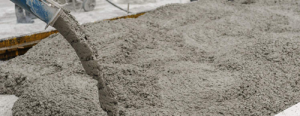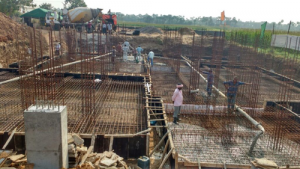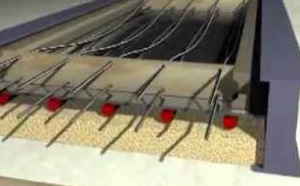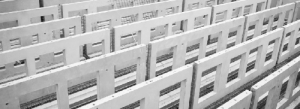Types of concrete
Concrete can be broadly classified into following:
Plain cement concrete [P.C.C]
It is obtained by making mixing cement, sand and coarse aggregates with an adequate quantity of water. P.C.C. is very strong in compression and very weak in tension. It has good weathering resistant and impervious. It has good resistance to abrasion and is hard and durable.
Uses
- It is used in foundation masonry, the base for foundation, flooring base.
- Mass concrete work in the construction of gravity dams and retaining wall.
Reinforced cement concrete [R.C.C]
It is obtained by reinforcing steel in the mixture of cement and coarse aggregate with an adequate quantity of water. R.C.C. is equally strong in compression and tension. It is hard, durable and bears all type of stresses. R.C.C. is used for columns, beams, slabs, foundations, retaining walls, water and oil tanks, road pavements, concrete pipes.
Uses of R.C.C
- It is used in the construction of the multi-storied building.
- It is used for the construction of water and oil tanks, bridges, concrete pipes.
- It is used for the construction of road pavement.
- It is used marine structures hydraulic structures with some anticorrosive admixtures.
Advantages of R.C.C.
- The fluidity of concrete and flexibility of reinforcement make it possible to mold the member into a variety of shapes desired.
- Its monolithic character provides more rigidity to the structure.
- It is highly durable and fire-resisting. It is not affected by vermin, termites, fungus, or such other insects.
- Care and cost of maintains of R.C.C. are almost negligible.
Prestress concrete
It is a modification of reinforced concrete which not only eliminates’ the weakness of concrete in tension but also makes it possible to take full advantages of before the external loads are applied by including tensile stresses in the reinforced to counteract tensile stresses in the concrete caused by external loads.
Methods of prestressing:
There are two methods
- Pre-tensioning
In this method for pre-tensioning the member, the tenders are prestressed in place in the form before concrete is poured. The tendons consist of small diameter high tensile steel wires. These tendons are first stretched to the desired tension in the form by a hydraulic jack and then anchored at their ends.
Concrete is now poured in form or mold and they’re allowed from their anchorages.
These tendons beings high tension wires, try to return to their original position. However, because of the bond between concrete and tendon, these tendons cannot return back to their original position and therefore induced a compressive force in the concrete members.
- Post-tensioning
In this method, the tendons are given the required tension after the concrete has attained the desired strength. In this system, the tendons are enclosed in ducts or metal sheets which prevent them from bonding to concrete. After the concrete has attained the required minimum strength the ends of the side of the precast member. After stretching, the tendons are anchored at the ends of the side of concrete member inducing compressive stress in it.
Uses
- Prestress concrete girders are used in bridge construction.
- The large span beams are possible with prestressing concrete.
- Railway sleepers and electric poles are examples of prestressed concrete.
- Used in construction of nuclear power stations, steel plants, piles transmission poles, and silos.
Advantages
- The size of structural members is reduced.
- These can sustain effects of impact, shocks, and vibrations.
- It permits the uses of large spans with shallow members, even when heavy loads are encountered.
- High-quality materials used.
Precast concrete
When a large number of components of similar dimensions is required, the option is to use precast concrete units produced in a factory. When individual concrete units or members of varies types which are costly in separate form before they are placed in the structure is known as precast concrete members.
Hollow concrete blocks. Tiles, pipes, roof slabs, electric poles, fencing posts. Staircase railing balusters are common examples.
Uses of precast concrete
- In the production of building component like beams, columns, slabs, stairs, water tanks, partition walls septic tank, step units, cladding panels, manholes, water supply and drainage pipes, fencing posts etc.
- In the production of industrial elements such as girders, funicular trusses, portal frames, shells, domes, pressure vessels etc.
- In the production of electric poles, piles, caisson, shaft lining, wharves, road dividers, traffic barriers, to tripods etc.
Advantages of precast concrete
- The concrete of superior quality can be produced because it is possible to have better quality control on the production in the factory.
- Smoother exposed surfaces can be achieved and hence plastering may not be required.
- The precast members of the desired shape can be made with greater accuracy.
Ready-mixed concrete [RMC]
It is that concrete which is supplied by ‘’ready mixed concrete plant’’ under controlled conditions like electronic weighing, controlled materials, and proper mixture proportioning. Here, the consumer can specify the concrete of this his needs. Now a day’s RMC has received considerable importance over site mixed concrete since it has many advantages.
Advantages of RMC
- Uniform assured the quality of concrete
- Removes any changes of mishandling and adulteration
- Durability of concrete
- Faster construction speed
- Storage needs at construction sites eliminated
- Admixture addition is easier
- Documentation of the mix design
- Reduction in wastage of materials
- RMC is eco- friendly.




